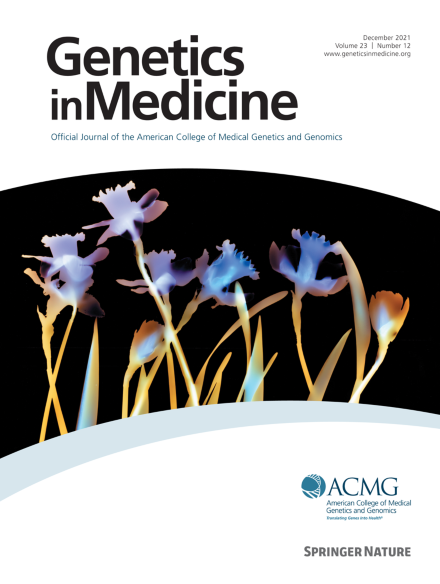High yield of monogenic short stature in children from Kurdistan, Iraq: A genetic testing algorithm for consanguineous families
IF 6.6
1区 医学
Q1 GENETICS & HEREDITY
引用次数: 0
Abstract
Purpose
Genetic testing in consanguineous families advances the general comprehension of pathophysiological pathways. However, short stature (SS) genetics remain unexplored in a defined consanguineous cohort. This study examines a unique pediatric cohort from Sulaimani, Iraq, aiming to inspire a genetic testing algorithm for similar populations.
Methods
Among 280 SS referrals from 2018-2020, 64 children met inclusion criteria (from consanguineous families; height ≤ −2.25 SD), 51 provided informed consent (30 females; 31 syndromic SS) and underwent investigation, primarily via exome sequencing. Prioritized variants were evaluated by the American College of Medical Genetics and Genomics standards. A comparative analysis was conducted by juxtaposing our findings against published gene panels for SS.
Results
A genetic cause of SS was elucidated in 31 of 51 (61%) participants. Pathogenic variants were found in genes involved in the GH-IGF-1 axis (GHR and SOX3), thyroid axis (TSHR), growth plate (CTSK, COL1A2, COL10A1, DYM, FN1, LTBP3, MMP13, NPR2, and SHOX), signal transduction (PTPN11), DNA/RNA replication (DNAJC21, GZF1, and LIG4), cytoskeletal structure (CCDC8, FLNA, and PCNT), transmembrane transport (SLC34A3 and SLC7A7), enzyme coding (CYP27B1, GALNS, and GNPTG), and ciliogenesis (CFAP410). Two additional participants had Silver-Russell syndrome and 1 had del22q.11.21. Syndromic SS was predictive in identifying a monogenic condition. Using a gene panel would yield positive results in only 10% to 33% of cases.
Conclusion
A tailored testing strategy is essential to increase diagnostic yield in children with SS from consanguineous populations.
伊拉克库尔德斯坦儿童单基因矮身材的高发率:近亲结婚家庭的基因检测算法。
导言:近亲结婚家族的基因检测有助于全面了解病理生理途径。然而,身材矮小(SS)遗传学在确定的近亲群中仍未得到探索。本研究对伊拉克苏莱曼尼一个独特的儿科队列进行了研究,旨在为类似人群的基因检测算法提供启发:在 2018-2020 年转诊的 280 名 SS 中,64 名儿童符合纳入标准(来自近亲结婚家庭;身高≤-2.25 SD),51 名儿童提供了知情同意书(30 名女性;31 名综合征 SS)并接受了调查,主要是通过外显子组测序。根据 ACMG 标准对优先考虑的变异进行了评估。通过将我们的研究结果与已发表的 SS 基因面板并列,进行了比较分析:结果:31/51(61%)名参与者阐明了 SS 的遗传原因。在涉及 GH-IGF-1 轴(GHR、SOX3)、甲状腺轴(TSHR)、生长板(CTSK、COL1A2、COL10A1、DYM、FN1、LTBP3、MMP13、NPR2、SHOX)、信号转导(PTPN11)的基因中发现了致病变体、DNA/RNA复制(DNAJC21、GZF1、LIG4)、细胞骨架结构(CCDC8、FLNA、PCNT)、跨膜运输(SLC34A3、SLC7A7)、酶编码(CYP27B1、GALNS、GNPTG)和纤毛生成(CFAP410)。另有两名参与者患有 Silver-Russell 综合征,一人患有 del22q.11.21。综合征 SS 对确定单基因疾病具有预测性。使用基因面板只能在 10-33% 的病例中得出阳性结果:结论:量身定制的检测策略对于提高近亲繁殖的 SS 儿童的诊断率至关重要。
本文章由计算机程序翻译,如有差异,请以英文原文为准。
求助全文
约1分钟内获得全文
求助全文
来源期刊

Genetics in Medicine
医学-遗传学
CiteScore
15.20
自引率
6.80%
发文量
857
审稿时长
1.3 weeks
期刊介绍:
Genetics in Medicine (GIM) is the official journal of the American College of Medical Genetics and Genomics. The journal''s mission is to enhance the knowledge, understanding, and practice of medical genetics and genomics through publications in clinical and laboratory genetics and genomics, including ethical, legal, and social issues as well as public health.
GIM encourages research that combats racism, includes diverse populations and is written by authors from diverse and underrepresented backgrounds.
 求助内容:
求助内容: 应助结果提醒方式:
应助结果提醒方式:


